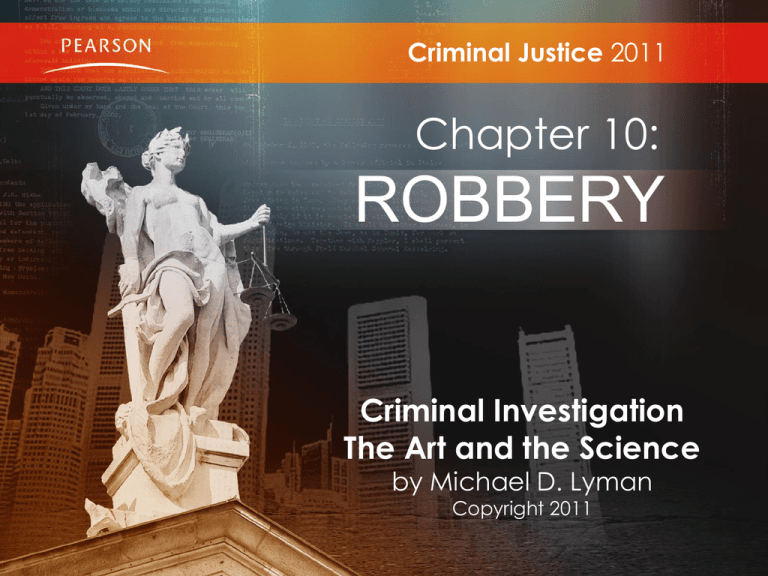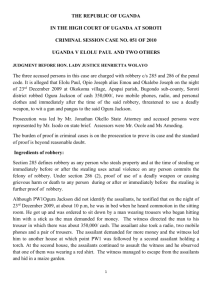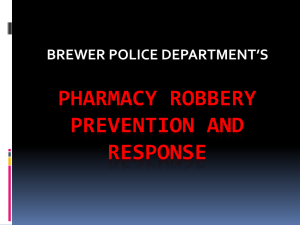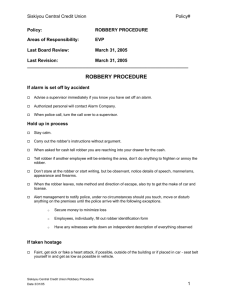Chapter 10
advertisement

Criminal Justice 2011 Chapter 10: ROBBERY Criminal Investigation The Art and the Science by Michael D. Lyman Copyright 2011 CHAPTER SUMMARY 10.1 Understand the motivations behind the crime of robbery. 10.2 Identify the legal elements of the crime of robbery. 10.3 List the steps to follow in the preliminary investigation of robbery offenses. 10.4 Identify various types of physical evidence found in robberies. 10.5 Appreciate the role of the witness in a robbery investigation. 10.6 Explain the function of the neighborhood canvass during a preliminary investigation. Learning Objectives After this lecture, you should be able to complete the following Learning Outcome 10.1 Understand the motivations behind the crime of robbery. 10.1 Robbery Motives 1. Money 2. Thrills 3. Drugs and alcohol 10.1 Robbery Down 2.2% 10.1 Bank Robberies Reported to the FBI Here are the totals for all Bank incidents in 2010 including robberies: Commercial Banks Mutual Savings Banks Savings and Loan Associations Credit Unions Armored Company Total Robberies Burglaries 4997 47 103 57 4 2 5 0 0 396 3 5,546 11 0 74 1 2 8 Larcenies 10.1 Total $$ Taken Total Loot Taken in 2010 broken down by type Cash $42,535,474.99 Securities—Face Value $301.00 Checks (Including $479,523.08 Photo Traveler’s Checks) placeholder Food Stamps $0.00 Other Property $800.00 Total $43,016,099.07 10.1 Robbery Statistics $1321 average per robbery $$$ taken in robberies $4201average bank robbery Learning Objectives After this lecture, you should be able to complete the following Learning Outcome 10.2 Identify the legal elements of the crime of robbery. 10.2 Robbery Defined The Uniform Crime Reporting Program defines robbery as the taking or attempting to take anything of value from the care, custody, or control of a person or persons by force or threat of force or violence or by putting the victim in fear Learning Objectives After this lecture, you should be able to complete the following Learning Outcome 10.3 List the steps to follow in the preliminary investigation of robbery offenses. 10.3 Robbery Investigation Steps One: Respond to the scene - no lights or siren Two: Assess the situation/handle emergencies/make arrest Three: Protect the crime scene Four: Identify and briefly interview witnesses Five: Send out crime broadcast Six: Thoroughly interview witnesses Seven: Recover video recordings, collect evidence, document scene 10.3 Robbery Investigation Physical Evidence Conviction Testimonial Evidence Learning Objectives After this lecture, you should be able to complete the following Learning Outcome 10.4 Identify various types of physical evidence found in robberies. 10.4 Evidence in Robbery Investigations Fingerprints Binding material DNA Notes Fired cartridges 10.4 Robbery Investigation Collecting Evidence Photo placeholder Learning Objectives After this lecture, you should be able to complete the following Learning Outcome 10.5 Appreciate the role of the witness in a robbery investigation. 10.5 Robbery Investigations Witnesses Photo placeholder 10.5 Finding Witnesses At the scene Neighborhood canvas Crime stoppers Offer rewards or seek informants Learning Objectives After this lecture, you should be able to complete the following Learning Outcome 10.6 Explain the function of the neighborhood canvass during a preliminary investigation. 10.6 The Neighborhood Canvas Seek witness near likely escape routes and question residents and business owners in the area 10.6 The Neighborhood Canvas While the canvass is in progress, officers should look for evidence discarded by the suspect during his or her escape. 10.6 The Neighborhood Canvas Because many citizens are apprehensive about the presence of officers at their residence, investigators should immediately state their intended purpose is to place the citizen at ease. 10.6 The Neighborhood Canvas Seek witness near likely escape routes and question residents and business owners in the area 10.6 The Neighborhood Canvas It is important for the officer to stress the significance of all information, regardless of how meaningless it appears to the citizen. Learning Objectives After this lecture, you should be able to complete the following Learning Outcome Robbery In General… Robbery Types Based on the location Commercial Street Residential School Robbery Types Based on the location Photo placeholder Robber Types Based on the force involved Armed Robbery Strong-arm Robbery Threatened Weapon Robbery Robber Types Based on the typology Professional Robber Opportunistic Robber Drug Addict Robber Alcoholic Robber Class Exercise Classify this robbery by type, location, and force Photo placeholder CHAPTER REVIEW 8.1 Summarize the trends and elements of robbery. 8.2 Differentiate between the types of robbery. 8.3 Identify robber types and characteristics. 8.4 Explain how a robbery investigation is conducted. 8.5 Describe the use of evidence and witnesses in robbery investigations.











